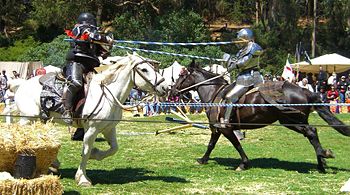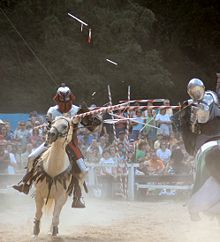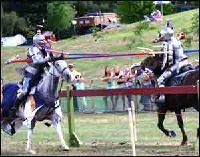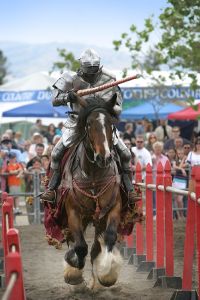Difference between revisions of "Jousting" - New World Encyclopedia
m |
|||
| Line 10: | Line 10: | ||
[[Image:Codex Manesse 081 Walther von Klingen.jpg|thumb|220px|Depiction of a late 13th century joust in the [[Codex Manesse]]]] | [[Image:Codex Manesse 081 Walther von Klingen.jpg|thumb|220px|Depiction of a late 13th century joust in the [[Codex Manesse]]]] | ||
| − | The skills and techniques used in jousting were | + | The skills and techniques used in jousting were first used in [[combat]], as mounted knights would charge at their enemies with weapons to try to kill or disable them. The primary use of the jousting [[lance]] was to unhorse the other by striking them with the end of the lance while riding towards them at high speed. This is known as "tilting." [[melee weapons|Other weapons]] were used for jousting included maces, morning stars, various pole weapons, swords, and daggers. |
===War put on hold for a joust=== | ===War put on hold for a joust=== | ||
[[Image:Corbould edward henry thejoustbetweenthelordofthetournament.jpg|thumb|right|350px|''The joust between the Lord of the Tournament and the Knight of the Red Rose'']] | [[Image:Corbould edward henry thejoustbetweenthelordofthetournament.jpg|thumb|right|350px|''The joust between the Lord of the Tournament and the Knight of the Red Rose'']] | ||
| − | The 1300s document | + | The 1300s document ''[[Froissart's Chronicles|The Chronicles of Froissart]]'' contains many details concerning jousting in medieval times. For example, much can be gleaned from its account of a war put on hold for a joust as it illustrates and documents: |
*the connection between romance and jousting | *the connection between romance and jousting | ||
Revision as of 21:47, 1 January 2009
Jousting is a sport consisting of martial competition between two mounted knights or other horsemen using a variety of weapons lances, battle axes, swords and daggers. The sport originate as a ritualized form of friendly battle at medieval tournaments.
The joust permitted a display of individual skill and often offered large sums of prize money. Many knights made their fortune in these events, while others lost their wealth or even their lives. Most famous of these deaths resulted when a shard of an opponent's broken lance went through the visor and into the eye of Henry II of France.
The first recorded tournament was staged in 1066. However jousting did not gain in widespread popularity until the thirteenth century. In England, jousting was the highlight of the Accession Day tilts of Elizabeth I and James I, and also was part of the festivities at the marriage of Charles I. The sport maintained its status as a popular European event until the early seventeenth century and today has seen a modest resurgence at fairs and dinner theaters.
Medieval jousting
The skills and techniques used in jousting were first used in combat, as mounted knights would charge at their enemies with weapons to try to kill or disable them. The primary use of the jousting lance was to unhorse the other by striking them with the end of the lance while riding towards them at high speed. This is known as "tilting." Other weapons were used for jousting included maces, morning stars, various pole weapons, swords, and daggers.
War put on hold for a joust
The 1300s document The Chronicles of Froissart contains many details concerning jousting in medieval times. For example, much can be gleaned from its account of a war put on hold for a joust as it illustrates and documents:
- the connection between romance and jousting
- the importance associated with jousting
- the nonlethal expectations
- the use of attendants
- the rounds consisting of three encounters with various weapons
- jousting being stopped when the risk of death seemed too great
- the financial rewards of acquitting yourself well
- tournaments contained jousts but jousts were also done outside of tournaments
- jousts contained tilts but tilts were but one type of armed encounter during a joust
- jousting as sport and not war was done between enemies during a war between warring sides, at least this once
- the completion of a joust could be delayed days and finished later
- standards of conduct considered honorable
The Chronicles of Froissart records that, during a campaign in the Gatinois and the Beauce in France during the Hundred Years War between the English and French, a squire from Beauce named Gauvain Micaille yelled out to the English, "Is there among you any gentleman who for the love of his lady is willing to try with me some feat of arms? If there should be any such, here I am, quite ready to sally forth completely armed and mounted, to tilt three courses with the lance, to give three blows with the battle axe, and three strokes with the dagger. Now look, you English, if there be none among you in love." This is what Froissart says happened next:
His proposal and request was soon spread among the English, when a squire, an expert man at tournaments, called Joachim Cator, stepped forth and said, "I will deliver him from his vow: let him make haste and come out of the castle."
Upon this, the lord Fitzwalter, marshal of the army, went up to the barriers, and said to Sir Guy de Baveux, "Let your squire come forth: he has found one who will cheerfully deliver him; and we will afford him every security."
Gauvian Micaille was much rejoiced on hearing these words. He immediately armed himself, in which the lords assisted, in putting on the different pieces, and mounted him on a horse, which they gave to him. Attended by two others, he came out of the castle; and his varlets carried three lances, three battle-axes, and three daggers. He was much looked at by the English, for they did not think any Frenchman would have engaged body to body. There were besides to be three strokes with a sword, and with all other sorts of arms. Gauvain had three brought with him for fear any should break.
The earl of Buckingham, hearing of this combat, said he would see it, and mounted his horse, attended by the earls of Stafford and Devonshire. On this account, the assault on Toury ceased. The Englishman that was to tilt was brought forward, completely armed and mounted on a good horse. When they had taken their stations, they gave to each of them a spear, and the tilt began; but neither of them struck the other, from the mettlesomeness of their horses. They hit the second onset, but it was by darting their spears; on which the earl of Buckingham cried out, "Hola hola! It is now late. Put an end to it, for they have done enough this day: we will make them finish it when we have more leisure than we have at this moment, and take great care that as much attention is paid to the French squire as to our own; and order some one to tell those in the castle not to be uneasy about him, for we shall carry him with us to complete his enterprise, but not as a prisoner; and that when he shall have been delivered, if he escape with his life, we will send him back in all safety."
[…] On the day of the feast of our Lady, Gauvain Micaille and Joachim Cator were armed, and mounted to finish their engagement. They met each other roughly with spears, and the French squire tilted much to the satisfaction of the earl: but the Englishman kept his spear too low, and at last struck it into the thigh of the Frenchman. The earl of Buckingham as well as the other lords were much enraged by this, and said it was tilting dishonorably; but he excused himself, by declaring it was solely owing to the restiveness of his horse. Then were given the three thrusts with the sword; and the earl declared they had done enough, and would not have it longer continued, for he perceived the French squire bled exceedingly: the other lords were of the same opinion. Gauvain Micaille was therefore disarmed and his wound dressed. The earl sent him one hundred francs by a herald, with leave to return to his own garrison in safety, adding that he had acquitted himself much to his satisfaction.[1]
Equipment
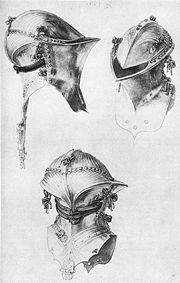
The lists
The lists, or list field, is the arena in which a jousting event or similar tournament is held. More precisely, it is the roped-off enclosure where tournament fighting takes place. It is mentioned frequently in the novel Ivanhoe by Sir Walter Scott.[2] In the late medieval period, castles and palaces were augmented by purpose-built tiltyards as a venue for "jousting tournaments."
The horse
The two most common kinds of horse used for jousting were warmblood chargers and coldblood destriers. Chargers were medium-weight horses bred and trained for agility and stamina, while destriers were heavy war horses. These were larger and slower, but helpful to give devastating force to the rider's lance through its weight being about twice as great as that of a traditional riding horse. The horses were trained for ambling, a kind of pace that provided the rider with stability in order to be able to focus and aim better with the lance.
During a jousting tournament, the horses were cared for by their grooms in their respective tents. They wore caparisons, a type of ornamental cloth featuring the owner's heraldic signs. Competing horses had their heads protected by a chanfron, an iron shield for protection from otherwise lethal lance hits.
Other forms of equipment on the horse included long-necked spurs which enabled the rider to control the horse with extended legs, a saddle with a high back to provide leverage during the charge or when hit, as well as stirrups for the necessary leverage to deliver blows with the lance.
The armor
Jousting was popular from the Middle Ages until the early 1600s. During that time, armor evolved from being chain mail (called simply mail at the time), with a solid, heavy helmet, called a "great helm," and shield. By 1400 knights wore full suits of plate armor, called a "harness." A full harness frequently included extra pieces specifically for use in jousting, so that a light, military-combat suit could be reinforced with heavier, "bolt-on" protective plates on the cuirass (breastplate) and helmet, and also with jousting-specific arm and shoulder pieces, which traded mobility for extra protection. These extra pieces were usually much stronger on the side expected to take the impact of the lance.
Special jousting helmets were sometimes used, made so that the wearer could only see out by leaning forwards. If the wearer straightened up just before the impact of the lance, the eyes would be completely protected. Some later suits had a small shield built-in the left side of the armor. In some cases, this was spring loaded to fly into pieces if struck properly by the opponent's lance.
The lance
In modern times, jousting is often done for show or demonstration purposes, and the lances used are usually made of light wood and prepared so that they break easily. Lances were often decorated with stripes or the colors of a knight's coat of arms. In a real joust, the lances were of solid oak and a significant strike was needed to shatter them. However, the (blunt) lances would not usually penetrate the steel. The harnesses worn by the knights were lined on the inside with plenty of cloth to soften the blow from the lance.
Modern-day jousting
Modern-day jousting, or tilting, has been kept alive by the International Jousting Association, [1], which has strict guidelines for the quality and authenticity of jousters' armor and equipment, and has developed the use of breakable lance tips for safety.
Jousting under the IJA rules follows a points system where points are given for breaking the lance tip on the opposing knights shield. However, there are no points given for unhorsing an opponent. IJA sanctioned tournaments also include skill at arms where the riders display their horsemanship and weapons handling skills with swords on the Moors Head, using spears for the rings and spear throw, and employing the lance against a spinning quintain. Many IJA tournaments also include a mounted melee with fully armored riders using padded batons in place of swords for safety. None of the IJA events are theatrically based and they offer the public a chance to observe living history as opposed to the Renaissance Fair-type of entertainment jousting.
Today, tent pegging is the only form of jousting officially recognized by the International Federation for Equestrian Sports. The sport involves using a lance or sword to strike and carry away a small wooden ground target. The name "tent pegging" is derived from the cavalry tactic of causing confusion in enemy camps by galloping though the camps and collapsing the tents by pulling up the tent peg anchors with well-placed lance tip strikes. The actual sport of tent pegging, however, originates in medieval India, when horse cavalrymen would try to incapacitate elephant cavalry by striking the elephants with lances on their extremely sensitive toenails[3].
Ring jousting is the official state sport of Maryland, and was the first official sport of any American state. In Port Republic, Maryland the annual Calvert County Jousting Tournament is held every August on the grounds of historic Christ Episcopal Church. In 2005, the tournament was featured in an edition of ESPN's SportsCenter.
The Italian town of Foligno also holds an annual jousting tournament, the Giostra della Quintana, that dates back to the 1613. The Knights have to spear rings from the statue of the Quintana.
The Italian town of Arezzo continues to hold an annual jousting tournament, which dates to the Crusades. Jousters aim for a square target attached to a wooden effigy of a Saracen king, whose opposite arm holds a cat-o-three-tails—three leather laces with a heavy wooden ball at the end of each lace. The riders strike the target with chalk-tipped lances and score points for accuracy, but must also dodge the cat-o-three-tails after they have struck the target.
Modern theatrical jousting competitions are popular at American Renaissance fairs and similar festivals, and feature riders on horseback attempting various feats of skill with the lance, which may not always have a basis in history.
Several international organizations, such as the Society for Creative Anachronism and the International Jousting Association, promote rules to govern their jousting events.[4]
Many bicycle gangs participate in jousting at the end of all day parties. [5] Two riders mount tall bikes and ride toward one another with a padded lance made of PVC resembling a giant Q-Tip.
Notes
- ↑ Cite error: Invalid
<ref>tag; no text was provided for refs namedFroissart - ↑ Ivanhoe
- ↑ "Tent pegging with Unicef Team Canada", retrieved 2007
- ↑ "Society Equestrian Marshal", retrieved 2007
- ↑ EasyBeezie "BiKE KiLL" You Tube. Joust at minute mark 7:39. Uploaded January 14, 2007.
ReferencesISBN links support NWE through referral fees
- Clephan, R. Coltman. The Meieval Tournament. New York: Dover Publications, 1995. ISBN 978-0486286204
- Gravett, Christopher. Knights at Tournament. Oxford: Osprey Publishing, 1999. ISBN 978-1855329379
- Strong, Roy. The Cult of Elizabeth: Elizabethan Portraiture and Pageantry. New York: Thames and Hudson, 1977. ISBN 0500232636
- Young, Alan. Tudor and Jacobean Tournaments. Dobbs Ferrey, MY: Sheridan House, 1987. ISBN 0911378758
External Links
- Tales from Froissart excerpts from 1849 edition of the Thomas Johnes translation (1805).
- From Lance to Pistol: The Evolution of Mounted Soldiers from 1550 to 1600 (myArmoury.com article)
- Tudor Joust Game (free, educational, online). British Galleries. Victoria and Albert Museum. Retrieved 2007-07-16.
Credits
New World Encyclopedia writers and editors rewrote and completed the Wikipedia article in accordance with New World Encyclopedia standards. This article abides by terms of the Creative Commons CC-by-sa 3.0 License (CC-by-sa), which may be used and disseminated with proper attribution. Credit is due under the terms of this license that can reference both the New World Encyclopedia contributors and the selfless volunteer contributors of the Wikimedia Foundation. To cite this article click here for a list of acceptable citing formats.The history of earlier contributions by wikipedians is accessible to researchers here:
The history of this article since it was imported to New World Encyclopedia:
Note: Some restrictions may apply to use of individual images which are separately licensed.
